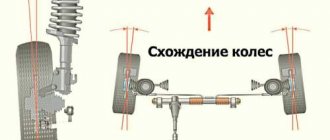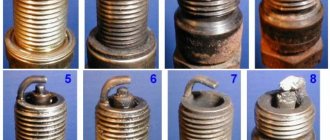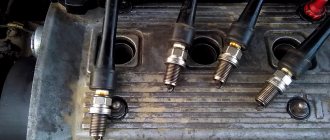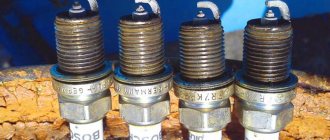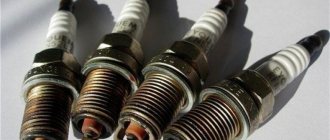High-quality combustion of fuel in the cylinders of a gasoline engine is possible only if there is an electric spark between the electrodes of the spark plugs. If the igniter elements of the air-fuel mixture are used that are unsuitable in type or technical condition, then the operation of the engine will be unstable. Incorrectly set spark plug gaps are also a common reason why the engine does not develop full power, runs at high fuel consumption and often overheats. In this case, the problem can be completely resolved with a simple adjustment operation.
Why is a gap between electrodes necessary?
The key to stable engine operation is the good condition of the spark plugs, that is, the absence of carbon deposits on the electrodes and the correct gap between them. Now we have come close to this term.
The gap is the distance between the central and side or side (if there are several) electrodes of the spark plug.
The central one is the positive electrode; it is supplied with high voltage current from the ignition coil.
The side electrode is, respectively, negative. A spark or arc discharge passes between two electrodes, and it occurs at the moment an electrical impulse is supplied from the ignition coil. Its characteristics will primarily depend on the gap on the spark plug. It is the spark that ignites the working mixture in the cylinder. There will be no spark - there will be no fuel combustion, and, accordingly, no useful engine operation, either. What clearance is required for your car's engine can be found in the owner's manual. Or go the other way, in a car store, if you take a box of spark plugs, there will definitely be a list of makes and models of cars indicating the engines on which it can be installed.
I myself have repeatedly seen that car enthusiasts simply come to the store and ask the seller to select spark plugs for a certain car, that is, they don’t bother, but leave the selection to the seller. And if he makes a mistake... At the car service center, they won’t bother either, they will supply you with what you brought. As a result, we get that new spark plugs are installed on the car, and the engine runs even worse than with the old set. Therefore, I recommend choosing the spark plugs yourself, at least according to such a parameter as the gap, especially where I wrote in the paragraph above where to find it.
There are ranges of clearance values for engines with different types of power supply and ignition systems, for example:
- carburetor engines (VAZ, GAZ, etc.) with a breaker-distributor in the ignition system (if according to the collective farm, then a distributor): 0.5–0.6 mm.
- carburetor engines with electronic ignition: 0.7–0.8 mm.
- injection engines: 1.0–1.3 mm.
About the ignition operation
The spark plug is the last element that comes into contact with the fuel-air mixture. Its main function is to ignite the fuel at the moment when the piston is at top dead center. The voltage is supplied from high-voltage wires. In turn, the interval between spark supply is set by the ignition coil. When the piston is at TDC, a spark runs between the spark plug electrodes. It is the catalyst for this process.
The mixture ignites and the compression energy is transferred to the piston. After the gases are removed, the process is repeated again. However, in order for a spark to be able to properly pierce the electrodes and ignite the mixture, the gap must be optimal. It changes during use. Thus, a distinction is made between small and large gaps. We will discuss further how they affect engine operation.
What causes an incorrect spark plug gap?
The distance between the electrodes can deviate from the norm both up and down. Depending on which gap, increased or decreased, the consequences will be different.
Types of motors affected by incorrectly set gap
The most critical consequences of insufficient or excessively large distances between the electrodes of the spark plugs appear on carburetor engines. In contrast to electronic ignition systems, which are capable of reacting to some extent to the operation of spark plugs and compensating for problems that arise by changing the quality of the working mixture. The carburetor practically does not have such capabilities.
In addition, the electrical circuits of the simplest engines with a carburetor are designed for lower voltage than, for example, systems with an injector. Therefore, on carburetors, any deviations in the spark plug gap from the norm appear more clearly.
Increased clearance
This deviation is dangerous, first of all, because it can cause breakdown of the spark plug insulator or ignition coil. This happens because electricity strives to find the shortest path for itself.
If breakdown does not occur, there is a high probability of spark loss. In this case, the cylinder simply will not work and the engine will start to stall. A characteristic sign of an increased gap between the electrodes is popping noises in the exhaust system. At high speeds, misfires become especially noticeable.
Please note that over time, the electrodes burn, and the gap between them increases naturally. For this reason, it is advisable to check single-electrode spark plugs every 10-15 thousand kilometers. Multi-electrode spark plugs need to be checked much less frequently.
Reduced clearance
If the interelectrode gap is less than normal, the spark discharge that ignites the combustible mixture is very powerful and short. The latter leads to the fact that the fuel in the cylinders does not have time to ignite, and the spark plugs will begin to flood, and the engine will begin to stall.
At high speeds there is a high probability of arcing. Due to the fact that the distance between the electrodes is too small and the crankshaft speed is high, the spark does not have time to break, and a continuous stream of plasma is formed. As a result, the ignition coil may short out or, at a minimum, malfunctions in the operation of the power unit may occur.
Heat number and “self-cleaning”
Temperature processes in the combustion chambers of different engine models have some differences. For optimal performance of spark plugs in each specific engine, they are certified according to the calorific value of combustion - heat number. For example, on a Ford Focus it is 7 and is written in the marking PFR7S8EG, after PFR, they belong to the “cold” class, used on engines with increased compression and compression ratio, for fuel with a high octane number.
Candles have a “self-cleaning” property, which provides for the combustion of the resulting soot particles at temperatures above 450 C degrees. This effect has a positive impact on the duration, quality of work and freedom from malfunctions. As a result of actions such as:
Prolonged operation of the engine at idle speed. Long-term movement without load at speeds not exceeding 2500 per minute. Frequent trips of less than 50 km in gentle mode.
Self-cleaning does not occur and the result is that a motor malfunction will not take long to occur. Fuel consumption will increase, power will decrease, failures and interruptions in engine operation will appear. Spark plugs do not like gentle operation and require periodic drive and loads.
What is the norm
The normal value ranges from 0.4 to 1.3 mm. What should be the gap on the spark plugs depends on the type of system:
- In carburetor engines, where the function of the ignition distributor is performed by a distributor, that is, on a “classic” engine, the gap between the contacts should be from 0.5 to 0.6 mm.
- If the engine is carburetor, but the ignition is electronic, then set the gap to 0.7-0.8 mm.
- For injection engines, the optimal distance is in the range from 0.9 to 1.2 mm.
Taking these recommendations into account, you can ensure the most stable operation of the motor.
The value of optimal clearances
Acceptable operating parameters at which the system remains fully operational are gaps in the range of 0.6–1.2 mm. Clear values are selected depending on the type of power plant, various power supply and ignition systems. You should focus on the following characteristics:
- old carburetor engines, which have motors with a low compression ratio and mechanical sparking functionality, will work optimally at 0.6–0.7 mm;
- similar power plants with modernized contactless ignition using electronics will be effective at 0.8–0.9 mm;
- for naturally aspirated engines reinforced with turbines and equipped with an injection type injection, it is preferable to provide a gap of 1–1.2 mm.
When does spark plug gap need to be adjusted?
The gap on the spark plug is set at the manufacturing plant, and it should not worry the driver if the engine is running stable. But all cars can have problems in the combustion chamber, and many of them can be diagnosed by spark plug soot. Accordingly, in the event of certain malfunctions, the spark plug gap may change and will need to be set as recommended. Even with stable engine operation, the gap on low-quality spark plugs may change slightly, which is why it is not recommended to skimp on them. A slightly changed gap will affect fuel consumption, and the saying “the miser pays twice” will come into play.
Experienced car owners recommend checking the gap in the spark plugs and comparing it with the standards 2 times a year. This is due to the fact that every six months, caring drivers clean the spark plug from carbon deposits, and it is convenient to also adjust the gap during this procedure.
Engine diagnostics based on carbon deposits on insulators
Take this opportunity to look at the spark plug insulators; their appearance can tell you a lot; you just need to understand what it says. After all, this element of the ignition system works in the combustion chamber of the cylinder and all the processes taking place there are reflected in its condition and appearance. It would not be an exaggeration to say that it is also a diagnostic probe built into the heart of the engine.
- The spark plug insulators are in good working order and the engine is running should be light brown in color and should not have soot deposits or burnt oil. If the spark plug insulator and the central electrode are covered with a velvety black coating, then this indicates either a malfunction in the ignition system or incorrect adjustment of the system preparing the fuel-air mixture, and if the engine is fuel-injected, then one of the sensors of this system may fail.
- The color of the insulator from light gray to white without carbon deposits indicates an excessively lean mixture.
- The brick-red color of the insulator indicates deposits of tetraethyl lead on it and that this spark plug, without cleaning, will soon experience an electrical breakdown of the insulator and failure.
- Traces of oil on the spark plug, as you might guess, indicate increased oil consumption. To determine its cause, observe the exhaust immediately after starting the engine. If there is a blue cloud of smoke with the smell of burnt oil, this indicates that while the car was parked, oil has accumulated in the combustion chambers through the valve seals. So it's time to change the caps. If the smoke is all blue from starting the engine and beyond, then the reason for oil consumption is most likely wear on the piston rings.
- A thick, white, loose coating on the spark plug appears when antifreeze enters the combustion chamber; this happens when the gasket between the cylinder head and the cylinder block is defective or due to thermal deformation of the cylinder head. When an engine operates with such a malfunction, bubbles of exhaust gases are observed in the expansion tank, passing into the cooling system through the same defect. The exhaust from such a malfunction partly consists of coolant vapors.
How to measure the gap between electrodes
The gap between the electrodes changes during operation, since the spark plug is constantly exposed to electrical voltage and high pressure. It is recommended to check the distance between the electrodes every 15 thousand km. (or 30 thousand km for multi-electrode devices) and correct it.
To measure, you will need a special tool - a probe. Three types of tools are used:
- Coin-shaped - along the edge of the “coin” there is a thickening rim, which is the meter. Insert the rim between the electrodes and turn the “coin” so that the rim stands between them. Then look at the designation that is printed on the disk. It indicates the width of the rim at a specific point. The disadvantages of such a probe are that it can become worn down and can accidentally increase the gap between the contacts.
- The coin-wire device is also a round tool, but the gap is measured by inserting wires attached to the body between the electrodes. They have a fixed thickness, so it is not possible to accurately determine the distance.
- Flat probe - the tool is a set of probes that differ in thickness. It looks like a Swiss Army knife. To make a measurement, select a probe of the required thickness (several probes can be used). There are tools of a combined type with wires, that is, combining this and the previous options.
To measure the gap, the spark plugs are removed from the engine. To do this, you will need a 16 or 21 head. First, disconnect the armor wires, and then unscrew the spark plugs. The removed devices are cleaned to remove carbon deposits and obtain a reliable measurement result.
Important! A large amount of carbon deposits indicates that the spark plugs will soon need to be replaced. If the carbon deposits are not completely cleared, then putting them back is not recommended.
You can use a small piece of clean cloth for cleaning. If you cannot remove the deposits with a cloth, you should apply medical alcohol to the surfaces of the electrodes.
After cleaning, measure the gap with a tool by placing the probe between the electrodes. Select a probe that corresponds in thickness to the value that needs to be set. If the probe does not fit between the contact surfaces, then the gap needs to be increased. If the probe fits freely between the electrodes, you need to bend the contacts in the direction of decreasing the distance. The probe should fit tightly between the contacts.
Interelectrode gap measurements
Considering what spark plug gap affects, you should think about the gauging process. For this, there are special probes, which can be purchased on the shelves of spare parts stores. These devices are classified into three categories:
- Plate-shaped;
- In the form of a wire;
- In the form of a coin.
The plate-shaped probe is similar to a knife. The existing plates on the surface of the device allow you to accurately measure the distance. Wire and coin-type devices have almost the same design in the shape of a circle. A wire device is characterized by the presence of loops of wire with different circumferences. They serve to measure the size of the gap. The coin-like stylus is equipped with a rim, the layer of which varies depending on the position. There is also a scale to indicate the size of the gap.
To determine the distance between the electrodes using a coin-shaped probe , you need to follow the diagram:
- Remove dirt and carbon deposits from the surface of the spark plug;
- Place the rim of the probe in the interelectrode space;
- Rotate the device until the contact connection period;
- Determine the size using the scale;
- To increase the clearance, it is necessary to bend the side contact using the rim;
- To compress, carefully bend the contact by applying pressure.
When using a wire probe, the distance corresponds to a suitable wire loop located in the interelectrode space. Loop thickness is a measure of the length between pins. The device has shaped plates to increase the gap.
The plate probe allows you to easily and simply measure the required value using plates of different thicknesses. They are placed in the space between the contacts. The spark plug gap is adjusted using the device itself.
If you cannot adjust the distance using the device, you can use pliers and a flat-head screwdriver. You can tap the pliers lightly to reduce the gap. If you need to bend the side element, this can be done with a flat-head screwdriver.
What kind of gap are we talking about?
Of course, about the gap between the spark plug electrodes. The spark plug is the “weak link” of a gasoline engine. Is the engine difficult to start? Does it work intermittently? First of all, check the spark plugs. Carelessness can be costly!
How to set the spark plug gap
Let us immediately note that new spark plugs may have either an increased or decreased gap. As for the spark plugs that were already on the car, during operation it is only possible to increase the gap (the surface of the electrodes burns out), and not to decrease it. At the same time, it is important that such spark plugs themselves are not damaged, that the electrodes, as well as the insulator, are intact, etc.
Having taken new spark plugs or cleaned the old ones, the gap needs to be measured. Some people do this with a simple ruler, but you need to keep in mind that the error is at least 0.5 mm. For this reason, test probes, which are much more accurate, should be used.
By inserting a suitable probe from the set between the electrodes, you can determine the size of the gap. As an example, consider adjusting the spark plugs for the injector. If the gap is larger or smaller than the required mark, then it is recommended to first set the largest optimal gap of 1.3 mm. Alignment is performed by bending the electrode. Next, carefully bending the side electrode with a special tool, the gap is reduced to 1.1 mm. After adjustment, the gap on the spark plugs is checked again using a feeler gauge.
Reduced distance between electrodes
If this parameter is less than that recommended for this type of power unit, then the electric arc (spark) will be good, but short. In such a situation, most likely the short arc will not be enough to ignite the fuel-air mixture in the cylinder.
Since the mixture does not ignite, it means that it can flood the electrodes of the spark plug. The consequence of this will be that this cylinder is switched off from operation, that is, the engine will begin to “trouble.” If the gap is significantly smaller than recommended, the following can happen: when the internal combustion engine is running at high speeds, a powerful but short electric arc will not have time to open - there will be a continuous spark. The sad consequence of this may be a short circuit of the ignition coil.
Setup recommendations
Checking and adjusting the gap on the spark plugs of the ignition system is carried out in the following situations:
- After repairing the engine, power supply and ignition systems, or before measuring compression in the cylinders. During operation, the spark plug electrodes gradually burn out and become thinner, causing the gap between them to increase.
- When replacing spark plugs with new ones. Often the manufacturer sets the gaps too small, which have to be increased to normal.
- When the engine became unstable. The first step is to unscrew the spark plugs, thoroughly clean the contacts, adjust the interelectrode distances and check their performance under pressure.
Cleaning the electrodes and pads from carbon deposits should always precede adjustment.
An important point to remember is that it is impossible to clearly set the gap on the spark plugs without a feeler gauge. Adjusting by eye will do as a temporary measure until you get to the garage with the tool.
- Remove the spark plugs from the engine cylinders and allow them to cool to room temperature. It is impossible to measure the size of the gaps “hot”.
- Clean the contacts with a wire brush and check the gap between the electrodes with a probe of the required thickness. The latter should fit tightly between the contacts, with little resistance.
- If the feeler gauge does not fit, increase the gap by bending the top electrode with a flat-head screwdriver. Too large a distance can be removed by gently tapping the contact.
It is easier to perform the operation on a cooled engine - you won’t have to burn your hands while unscrewing. For regular spark plugs, use a flat probe, and for products with 2-3-4 side electrodes, use a round tool. Install the spark plugs in the cylinders, start the engine and observe the idle speed. If the previously noticed vibration does not stop, the fault should be looked for elsewhere.
Owning a car means regularly replacing many parts. One of these parts are spark plugs, which are responsible for the timely ignition of the air-gasoline mixture. Their performance is assessed by analyzing the gap between the electrodes. It can vary depending on many factors. Therefore, if problems arise in the operation of the engine, the spark plugs are first checked. In this case, the gap between the electrodes is assessed. Then you can ask the question - what should be the gap on the spark plugs so that there are no problems in a running car.
Interelectrode gap for different spark plugs
Cars that use gas as fuel involve a different method of fuel combustion. Thus, propane has a high octane number and high combustion temperatures. As a result, the use of spark plugs with the lowest heat value is required when refueling with 92-grade gasoline.
In a situation where the car is designed for 95 gasoline, then when installing gas equipment, you can use spark plugs with the recommended gap. Thus, it will not be possible to simply bend the side contact onto the spark plugs for a gas-powered unit.
Owners of foreign cars are often interested in the question: what gap between the spark plug and the “precious” electrode is considered normal? Spark plugs with a central contact made using iridium, platinum or silver are considered to be of higher quality. The contact gap in these parts is large. And the use of such “precious” metals affects the resistance of the material to high temperatures. This is based on the fact that the resulting spark charge is more stable and does not depend on the gap between the electrodes.
The reluctance to measure the spark plug gap is due to the slowdown in replacing old elements. But if you carry out this procedure in a store or directly at the car, you can avoid many problems during engine operation. After all, contacts can be damaged during transportation and loading, which in the future will affect the appearance of defects in the operation of the car.
The presence of interference when the fuel mixture ignites is often associated with improper operation of the spark plug, namely the inaccurate distance between the electrodes.
Signs of faulty spark plugs can be identified even by an inexperienced car enthusiast. An inexpensive part of the ignition system of a carburetor and injection internal combustion engine, it is indispensable for its stable operation. Their serviceability must be checked during scheduled maintenance, and replacement must be carried out in accordance with the regulations established by the manufacturer.
Is the gap the same for gasoline and gas?
Many car owners install gas equipment on their cars in order to save money. It is important to remember that gas requires other candles. Firstly, a mixture of gas and air ignites much worse than a mixture of gasoline and air, so the spark must be more powerful. Consequently, the load on the ignition coil increases, which can ultimately lead to its failure.
Thus, the interelectrode gap for gas should be smaller, but simply bending the side electrode does not completely solve the problem. The fact is that when gas burns, much more heat is released, because of this there is a high risk of glow ignition. In this regard, the candle should be “colder”, i.e. with a high heat number.
Design features and operating principle
Since the invention of the internal combustion engine, the principle of operation of the spark plug has not undergone major changes. Its main task is to convert electrical energy into a high-voltage arc, which ignites the fuel mixture in the combustion chamber.
- A ceramic insulator that ensures uninterrupted and stable spark formation.
- Metal housing for sealed installation in the engine.
- Electrodes for supplying and converting electric current into an arc (spark).
- The contact head, on many samples, has a thread for connection.
The most common, classic version of the candle has two electrodes, central and side. Current is supplied from the source through special high-voltage wires connected to the contact head to the spark plug, in the sequence established by the ignition system.
Increased distance between electrodes
The danger here lies in the possible breakdown of the spark plug insulator or even the ignition coil; the consequences of this are very unpleasant and costly. This occurs because current follows the path of least resistance.
Even if a breakdown does not occur, then, most likely, the increased gap will not provide the opportunity for the formation of a current arc, the so-called spark. The absence of a spark will lead to the fact that the working mixture in the cylinder will not ignite and, accordingly, this cylinder will not work. In such cases, they say that the engine is “troubling”, that is, 3 out of 4 cylinders are working. Also a sign of a larger gap than required is popping noises coming from the exhaust system.
An increase in the gap should not be attributed to any malfunction - this is a completely natural process that occurs over time, as the electrodes gradually burn out. Therefore, it is advisable to check the spark plugs during maintenance (after 10,000–15,000 km) and, if necessary, make adjustments, although the official dealer most likely will not “bother” with this topic and will simply offer a replacement.
Modern technologies
What I want to say in conclusion, many will think “come on,” why should I bother with some distance between the electrodes! Guys, very wrong thoughts.
Firstly, you can save on fuel, studies show up to 5 – 7%
Secondly, smooth engine operation is the key to driving safety.
Third, the correct gap between the spark plugs increases their service life; there is no chance that the insulator will break through (with an increased distance).
I would like to note that some companies, on the contrary, increase the number of contacts (electrodes), strengthen the coils and the ignition system, all so that the mixture is ignited better.
There are also more modern technologies now, which I think will soon replace them - such as plasma candles.
They have no electrodes at all, and the fuel is ignited by a beam of plasma that is generated by electricity. As they write, the production is now undergoing tests and they say that the combustion efficiency of the fuel mixture is increasing, which means a little more power, a little more economy and environmental friendliness of the engine.





